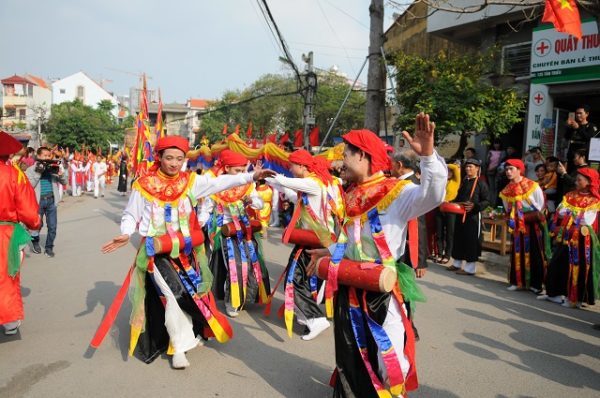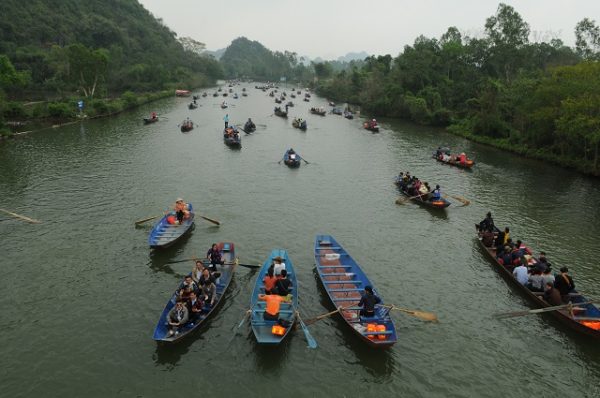Historically, each time the administrative boundary has changed, the range of cultural areas has also been fluctuated. When merging Hanoi – Ha Tay, there were many concerns about preserving and promoting the value of Thang Long culture in parallel with the culture of Doai
Historically, each time the administrative boundary has changed, the range of cultural areas has also been fluctuated. When merging Hanoi – Ha Tay, there were many concerns about preserving and promoting the value of Thang Long culture in parallel with the culture of Doai. But in fact, after 10 years of expanding the administrative boundaries of the Capital, the process of confluence of two major cultural lines has enriched the identity of the Capital’s culture.

Festival of Trieu Khuc village, Thanh Tri district. Picture: Pham Hung
Integration without dissolution
10 years is not long to feel the changes in culture, especially for the area with the tradition of 1000 years such as Thang Long – Hanoi, then Ha Tay and Me Linh as the cultural area of thousand years. Now, , it has the clear similarity between the old part and the extension part, which is the culture of the Red River delta. The unification of the two areas has enriched Hanoi’s cultural treasures. Among Four Immortals of Vietnam, Hanoi has three as Phu Dong Thien Vuong (Soc Son), Tan Vien (Ba Vi) and Chu Dong Tu (Gia Lam).
Many centuries ago, in thẻ Thăng Long Citadel, there was the presence of the famous trade villages in Đoài – Sơn Nam Thượng such as: Hàng Khay Street, built by Chuyên Mỹ people; Hàng Long Street (now Lê Duẩn Street), Hàng Thêu Street (now Yên Thái Lane) built by Quạt Động people; then, Thơ Tiền street (now To Tich street), built by the inhabitants of the Chàng Sơn, Hữu Bằng and Nhữ Khê villages, in addition, the villages such as Vạn Phúc, Cô Đồ, “Bảy Là – Ba Mô” (Mơ, Lạ, Cánh, Cot – “four reputable names”) of Đoài, specializing in providing silk for Hang Gai, Hang Dao – famous Silk Street of the Citadel.
In modern history, during the resistance war against France, President Ho Chi Minh wrote the call for national resistance in Ha Tay. There are also many similarities between the two cultures. The two big cultural regions with the same history of intergration, after merging, neither create cultural shock or clutter, nor lead to other economic and social shocks. Ten years after the merging, culture does not exhibit the unwanted variation. Doai and Thang Long remain unchanged. The characteristics of the culture of each region remain the same, with Integration without dissolution.
After merging and thorough analysis, it is also acknowledged that there is certain changes in environment and cultural landscape. Me Linh district is lighted with lamps, different from the melancholy of the previous period. The economy determines the change of culture. Cultural activities are more vibrant and diverse. At the same time, the culture of integration in the center increase the quantity and quality of cultural activities compared to before. The expansion of the administrative boundaries of the Capital brings many advantages.
Many artery traffic routes such as Thang Long Avenue, National Highway No. 32, National Highway No. 21A and 21B have been constructed and renovated, many bus routes are connected and much convenient than before. Thus, its take one hour from the center of the City to Duong Lam ancient village, or the vestiges of the Ba Vi district … The cultural tourism potential of Doai is gradually “awaken”. In contrast, the people of Doai have more favorable conditions to come to the Thang Long cultural heritage.

Tourists of Huong pagoda. Photo by Cong Hung
Avoiding inadequacies in management
However, after merging, Hanoi has the large area, which means that the number of legacies is also greater, especially those of special value pf Vietnam, both material and immaterial. Two administrative areas, after the merging, have been different in the management. Especially, the capacity of units as well as of the cultural sector has not met the thickness of the thousand-year heritage. Therefore, the events in which the Tram Gian pagoda (Chuong My) is dismantled and Duong Lam (Son Tay) villages apply for returning their title … is the lessons in management.
Due to the large amount, the investment in culture has spread, affecting conservation, such as the collapse of the heritage site in Co Loa (Dong Anh) according to scientists.
After the merging, the “overheating” urbanization, especially in the suburbs, has led to the local cultural shock. Agricultural land is used for urban development, and agricultural residents are compensated with much money but lose their land. The unreasonable money management leads to the consequences of social evils. Moreover, many festivals associated with agriculture are also fading. This requires the State to have the strategies of social security strategy and preservation of cultural heritage in life to prevent or limit cultural shock in urbanized areas.
Culture is influenced by political, economic and social situation. Overall, after merging, the culture welcomes both positive and negative changes, requiring the State management agencies to have solutions to improve the quality and efficiency of the work of the culture staffs at all levels. The intellect of the intellectuals in the Capital area are exploited to pay attention to promoting and spread the culture of the center. Urbanized area must be strictly managed to stop the offensive “suspended” culture project.
The adequate funding shall be set for the preservation of cultural values of the Capital. And Hanoi must be the first in creation of culture, especially in the cultural activity in the modern era. It must find ways to cultivate culture without destroying the culture of the thousand years but at the same time absorb the world culture and new technology of the 4.0 era.
According to the Economics & Urban
